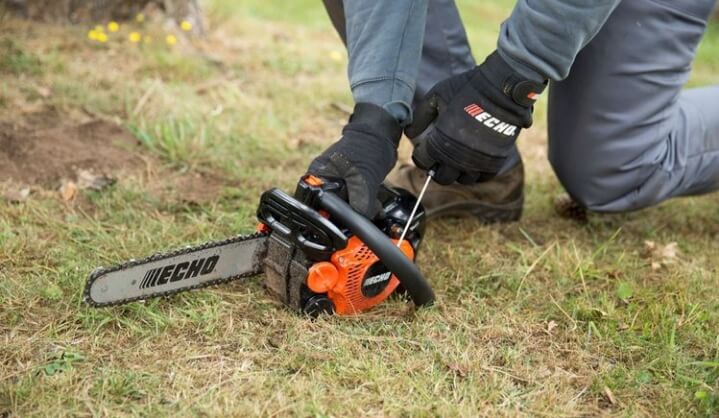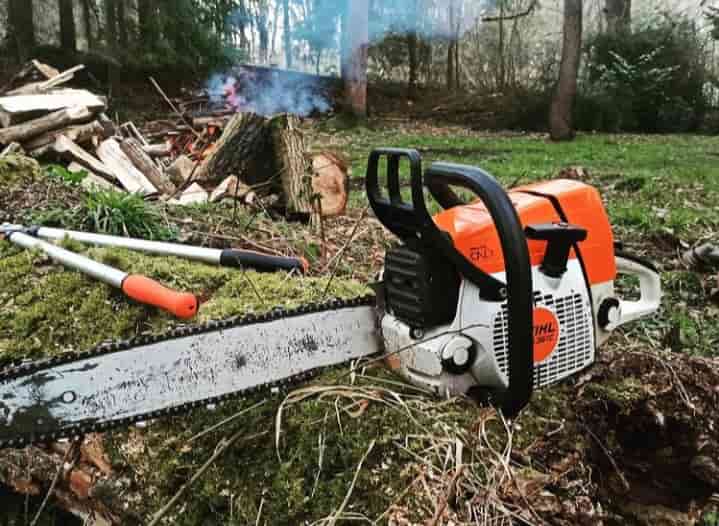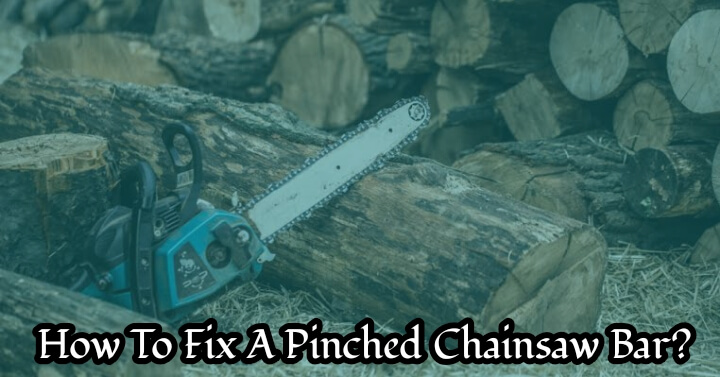A chainsaw bar pinch is a common problem that can occur while using a chainsaw. If the chainsaw bar is not properly lubricated, the metal-on-metal contact can cause the bar to become pinched.
This can lead to damage to the saw chain and the bar itself. Making sure the lubrication is satisfactory is essential for preventing this catastrophe.
You may not know how to fix [it] or you may believe that you can’t fix it. There’ll be tips on identifying a chainsaw bar pinch in this article.
Table of Contents
How do they happen and how to prevent them
Chainsaw bar pinching can be caused by a number of things, but the most common reasons are incorrect chain tension and a dull chain. If the chain is too tight, it can pinch the bar, which can lead to damage.
A dull chain can also cause the bar to pinch because it will not cut through the wood properly. To prevent chainsaw bar pinching, make sure the chain is properly tensioned and replace the dull chain with a new one. [1]
How To Fix A Pinched Chainsaw Bar: Step-by-Step Guide
Whether you are a professional or just an occasional user, sooner or later you will probably experience a chainsaw bar pinch.
This can be a very dangerous situation, but it can be fixed relatively easily if you know what to do. Here is a step-by-step guide to repairing a twist bar side clamp.

Step 1: Remove the bar from the chainsaw
Chainsaws are dangerous tools, and the bar is the part of the chainsaw that poses the most risk. Removing the bar from the chainsaw can make it much safer to use.
There are a few ways to do this, but all of them involve taking off the chain and then removing the bar. The easiest way to remove the chain is to loosen the screws that hold it in place, but be careful not to lose any of them.
Step 2: Use a bar clamp to straighten the bar
A bar clamp is a handy tool to have in your shop. It can be used to straighten a bar or to hold it in place while you work on it.
The clamp has two adjustable bars that fit around the bar and are tightened with a screw. This holds the bar in place and keeps it from moving. [1]
Step 3: Use a chainsaw file to remove any burs from the bar groove
Chainsaw chains need to be kept sharp in order to deliver the best performance and longest life possible. One way to achieve this is by filing the bar groove regularly.
However, before you can start filing, you need to remove any burs that may have formed in the groove. You can accomplish this quite quickly with a chainsaw file.
Step 4: Reattach the bar to the chainsaw and test it out.
Once your chainsaw is fixed, it is more important to test it out to make certain that it is working correctly. Hook up the bar to the chainsaw and make sure that it operates like the original saw.
Make sure to read the instructions for using the appliance carefully so that you know how to operate the chainsaw properly.
Step 5: Install your new blade guard.
The blade guard is an important component is of the saw. It helps guard your hands, fingers, and arms against the blade. When you’re installing a new blade guard, there are a few steps that you ought to keep in mind.
The first thing is to verify that the blade guard is appropriate for your saw. The next thing is to make sure that it is properly installed.
Tips for avoiding chainsaw bar pinching in the future

Chainsaw bar pinching is a common issue that can cause serious injury. In order to help avoid this, follow these tips:
1. Maintain a sharp chain and properly adjust the chain tension
When the chain saw is not in use, it’s important to keep the chain sharp and properly tensioned. If the chain saw isn’t maintained, it can cause the chain to break or come off the bar, which can lead to serious injury.
The most common way to sharpen a chain saw chain is with a chainsaw file. To sharpen the chain, hold the chainsaw file at a slight angle and file each tooth on the chain.
2. Inspect the chain for damage and replace it when necessary
The chain on a chainsaw is what does the cutting. It’s crucial to maintain the chain in good condition by inspecting it for damages and replacing them when necessary. Damage to the chain can include nicks, gouges, and excessive wear. Replacement of the chain may be necessary if the depth of the cut exceeds 0.025 inches (0.635 mm).
3. Keep the chain oiled and free of dirt and debris
A chainsaw is a powerful tool that can be used for many purposes, but it’s important to keep the chain oiled and free of dirt and debris to ensure smooth, safe operation.
If the chain becomes pinched, it can cause the saw to bind up and become difficult to control. There are several ways to fix a pinched chainsaw bar, depending on the severity of the pinch.
4. Make sure the correct size saw is used for the job
Chainsaws are a great tool to have around the house, but it is important to use the correct size saw for the job. A chainsaw that is too small for the job will be more difficult to use and can cause damage to the saw. A chainsaw that is too large for the job can be dangerous and may not be able to cut through the material.
5. Be mindful of your surroundings to avoid contact with items/people
When using a chainsaw, it is important to be aware of your surroundings and avoid contact with objects or people. One of the most common hazards when using a chainsaw is bar pinching.
This occurs when the saw chain contacts an object and the top of the bar are forced inward, trapping the fingers between the saw chain and the bar.
How do you Unpinch a chainsaw?
Chainsaw blades are sharp and can easily slice flesh if not handled properly. To avoid injury, it is important to unpinch the chainsaw blade before cutting. Here are a few tips on how to Unpinch a chainsaw:
1. Always wear safety goggles and gloves when using a chainsaw. It will protect you from injuries if the tool accidentally fires.
2. Keep your hands well away from the chain when it’s running – this is especially important when working with larger saws.
3. Hold the saw in both hands and use your thumbs to pinch the chain between them, slightly below where it connects to the bar. This will stop the blade from spinning and prevent injury.
4. Be sure to release your grip once you’ve unpinched the chain – otherwise, it could jump back out of position and cause injury again!
You might read our article on How to Make a Chainsaw Winch
Can you bend a chainsaw bar back?
This question is asked by many people, and the answer is yes. However, this task of using a strong power of arms cannot be accomplished easily and may require several pounds of force.
This is because the chain saw’s teeth are very sharp and they can easily cut through your hand if you try to bend the bar back too far.
If you do manage to bend the bar back far enough, the teeth on the chain saw will become accessible and you could potentially get injured if you attempt to use them.
How do you close the rails on a chainsaw bar?
When using a chainsaw, it is important to keep the chain sharp and properly lubricated to avoid any accidents. One way to close the rails on a chainsaw bar is to use a thumb lever.
To use this method, place your thumb on the top of the bar and push down with your other hand. This will close the rails and prevent them from spinning.
Conclusion
In conclusion, following these steps should help you avoid pinching your chainsaw bar and keep your saw running smoothly.
Be sure to use the correct chain tension, keep the chain sharp, and observe proper maintenance procedures.
By doing so, you can ensure that your chainsaw will function safely and effectively for years to come.

